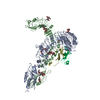+ Open data
Open data
- Basic information
Basic information
| Entry | Database: PDB / ID: 7b1b | ||||||
|---|---|---|---|---|---|---|---|
| Title | Cryo-EM of Aedes Aegypti Toll5A dimer bound to Spz1C | ||||||
 Components Components |
| ||||||
 Keywords Keywords | IMMUNE SYSTEM / Mosquito vector biology / Toll receptor / LRR / Cystine knot domain | ||||||
| Function / homology |  Function and homology information Function and homology informationToll binding / central nervous system formation / growth factor activity / signaling receptor activity / innate immune response / signal transduction / extracellular space / plasma membrane Similarity search - Function | ||||||
| Biological species |  | ||||||
| Method | ELECTRON MICROSCOPY / single particle reconstruction / cryo EM / Resolution: 4.23 Å | ||||||
 Authors Authors | Gangloff, M. / Hardwick, S.W. / Chirgadze, D.Y. | ||||||
| Funding support |  United Kingdom, 1items United Kingdom, 1items
| ||||||
 Citation Citation |  Journal: Nat Commun / Year: 2022 Journal: Nat Commun / Year: 2022Title: Structure and dynamics of Toll immunoreceptor activation in the mosquito Aedes aegypti. Authors: Yoann Saucereau / Thomas H Wilson / Matthew C K Tang / Martin C Moncrieffe / Steven W Hardwick / Dimitri Y Chirgadze / Sandro G Soares / Maria Jose Marcaida / Nicholas J Gay / Monique Gangloff /   Abstract: Aedes aegypti has evolved to become an efficient vector for arboviruses but the mechanisms of host-pathogen tolerance are unknown. Immunoreceptor Toll and its ligand Spaetzle have undergone ...Aedes aegypti has evolved to become an efficient vector for arboviruses but the mechanisms of host-pathogen tolerance are unknown. Immunoreceptor Toll and its ligand Spaetzle have undergone duplication which may allow neofunctionalization and adaptation. Here we present cryo-EM structures and biophysical characterisation of low affinity Toll5A complexes that display transient but specific interactions with Spaetzle1C, forming asymmetric complexes, with only one ligand clearly resolved. Loop structures of Spaetzle1C and Toll5A intercalate, temporarily bridging the receptor C-termini to promote signalling. By contrast unbound receptors form head-to-head homodimers that keep the juxtamembrane regions far apart in an inactive conformation. Interestingly the transcriptional signature of Spaetzle1C differs from other Spaetzle cytokines and controls genes involved in innate immunity, metabolism and tissue regeneration. Taken together our results explain how upregulation of Spaetzle1C in the midgut and Toll5A in the salivary gland shape the concomitant immune response. | ||||||
| History |
|
- Structure visualization
Structure visualization
| Structure viewer | Molecule:  Molmil Molmil Jmol/JSmol Jmol/JSmol |
|---|
- Downloads & links
Downloads & links
- Download
Download
| PDBx/mmCIF format |  7b1b.cif.gz 7b1b.cif.gz | 364.3 KB | Display |  PDBx/mmCIF format PDBx/mmCIF format |
|---|---|---|---|---|
| PDB format |  pdb7b1b.ent.gz pdb7b1b.ent.gz | 239.2 KB | Display |  PDB format PDB format |
| PDBx/mmJSON format |  7b1b.json.gz 7b1b.json.gz | Tree view |  PDBx/mmJSON format PDBx/mmJSON format | |
| Others |  Other downloads Other downloads |
-Validation report
| Summary document |  7b1b_validation.pdf.gz 7b1b_validation.pdf.gz | 2 MB | Display |  wwPDB validaton report wwPDB validaton report |
|---|---|---|---|---|
| Full document |  7b1b_full_validation.pdf.gz 7b1b_full_validation.pdf.gz | 2 MB | Display | |
| Data in XML |  7b1b_validation.xml.gz 7b1b_validation.xml.gz | 71.7 KB | Display | |
| Data in CIF |  7b1b_validation.cif.gz 7b1b_validation.cif.gz | 106.8 KB | Display | |
| Arichive directory |  https://data.pdbj.org/pub/pdb/validation_reports/b1/7b1b https://data.pdbj.org/pub/pdb/validation_reports/b1/7b1b ftp://data.pdbj.org/pub/pdb/validation_reports/b1/7b1b ftp://data.pdbj.org/pub/pdb/validation_reports/b1/7b1b | HTTPS FTP |
-Related structure data
| Related structure data |  11982MC  7b1cC  7b1dC C: citing same article ( M: map data used to model this data |
|---|---|
| Similar structure data | Similarity search - Function & homology  F&H Search F&H Search |
- Links
Links
- Assembly
Assembly
| Deposited unit | 
| |||||||||||||||||||||||||||||||||||||||||||||||||||||||||||||||||||||||||||||||||||||||||||||||||||||||||||||||||||||
|---|---|---|---|---|---|---|---|---|---|---|---|---|---|---|---|---|---|---|---|---|---|---|---|---|---|---|---|---|---|---|---|---|---|---|---|---|---|---|---|---|---|---|---|---|---|---|---|---|---|---|---|---|---|---|---|---|---|---|---|---|---|---|---|---|---|---|---|---|---|---|---|---|---|---|---|---|---|---|---|---|---|---|---|---|---|---|---|---|---|---|---|---|---|---|---|---|---|---|---|---|---|---|---|---|---|---|---|---|---|---|---|---|---|---|---|---|---|---|
| 1 |
| |||||||||||||||||||||||||||||||||||||||||||||||||||||||||||||||||||||||||||||||||||||||||||||||||||||||||||||||||||||
| Noncrystallographic symmetry (NCS) | NCS domain:
NCS domain segments:
|
 Movie
Movie Controller
Controller





 PDBj
PDBj





 SAXS
SAXS